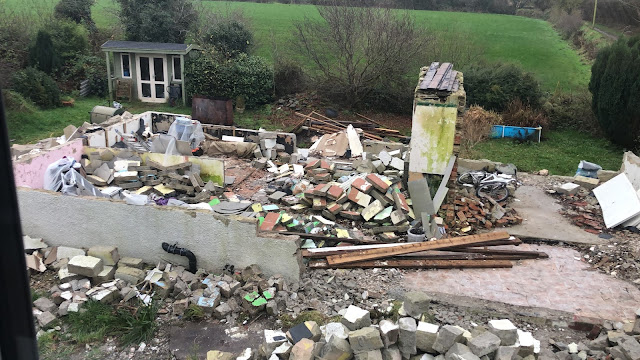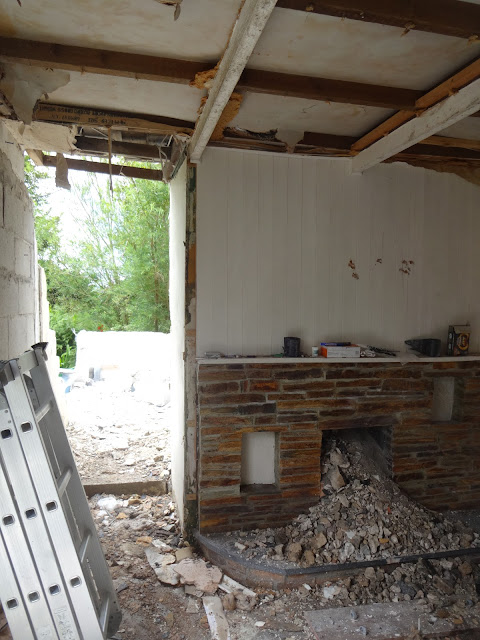A reminder of what the old house used to look like when we were living there back in 2012...
And the same view in 2020 after our recent 'modifications'...
It turns out knocking down a house is quite a messy business.
The 'ancient' mural that we had previously discovered hidden behind the bathroom wall coverings, almost matched the blue summer sky behind.
Those trees in the background look particularly realistic. No matter though, it was still going to get smashed to smithereens.
During the demolition of the mural wall, we noticed a small wooden box buried in-between the blocks!
Could this be the much hoped-for hidden treasure? Precious jewels or gold, concealed right under our noses, deep within the fabric of the building?
No such luck. It turned out to be just a crummy wooden box filled with cement, presumably constructed because the builders ran out of bricks and couldn't be bothered to go and buy some more. So we angrily pulverised it into dust with a sledgehammer for getting our hopes up.
We took all the windows out carefully with a view to selling them, but after a bit of research realised that they didn't have any value, so it was yet more stuff to add to the ever-growing scrap pile.
The sections of wall containing windows were a little easier to take down, as the columns of blocks either side of the glass were structurally weaker.
It was shocking how much rubble was being produced. Looking at the huge mounds of material building up, it felt like there was enough for 2 or 3 houses. Clearing the site was going to be a nightmare.
Removing a section of wall to the left of the old patio doors.
Before:
After:
Naturally, the site inspector climbed up the remaining walls to check their integrity and supervise the rest of the demolition.
Gradually the walls were knocked apart, one giant block at a time...
The garden was really opening up, but the mountains of rubble still made it hard to visualise how it would all look once it was clear.
From the main bedroom doors of the 'new' house, it was nice to see more and more of the landscape gradually being revealed.
A return to full-time employment meant progress on the demolition slowed, but still we spent most weekends chipping away at the remaining walls.
We had toyed with the idea of leaving the base of the chimney up (pictured on the left) as a garden feature, but it was a lot bigger than anticipated and not very attractive.
There were mountains of heavy rubble forming in every side of the garden.
The last remaining walls. Once they were down and the rubble shifted, we could start breaking up the concrete floor slabs and whatever foundations were under the walls... in hindsight it would have made a lot more sense to just get a demolition expert in to do it but the one guy we found messed us around so much that we gave up & did it ourselves (familiar story).
With the walls down, we had a better idea of what the new house would look like standing in the garden alone, but we had a lot more work to go before it was clear.

























































